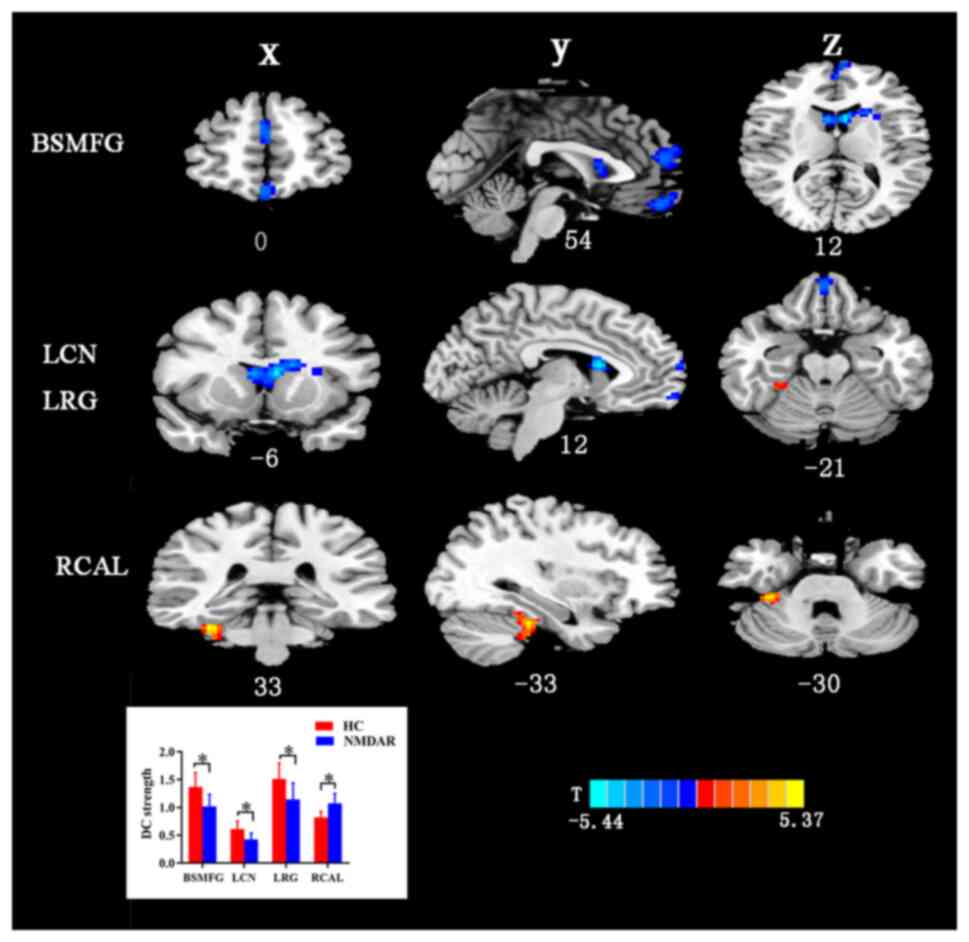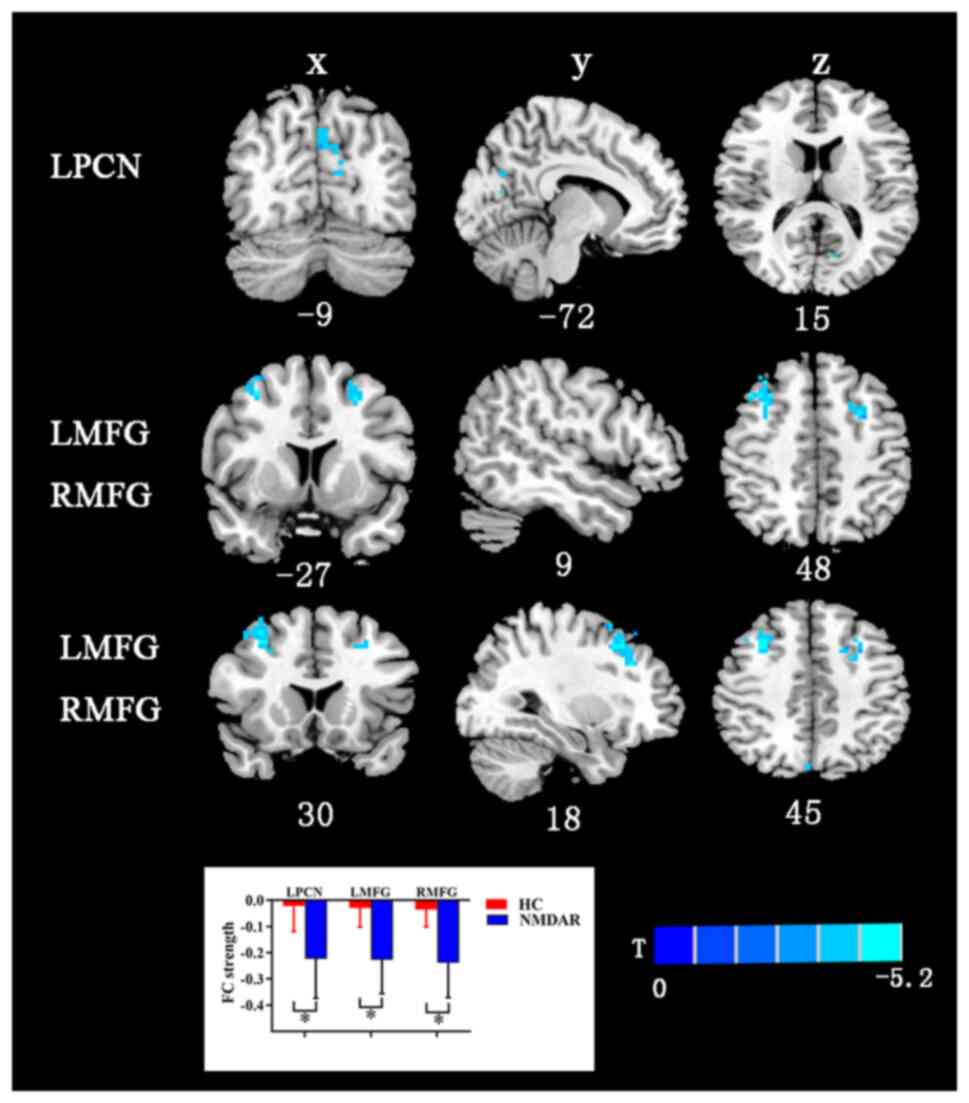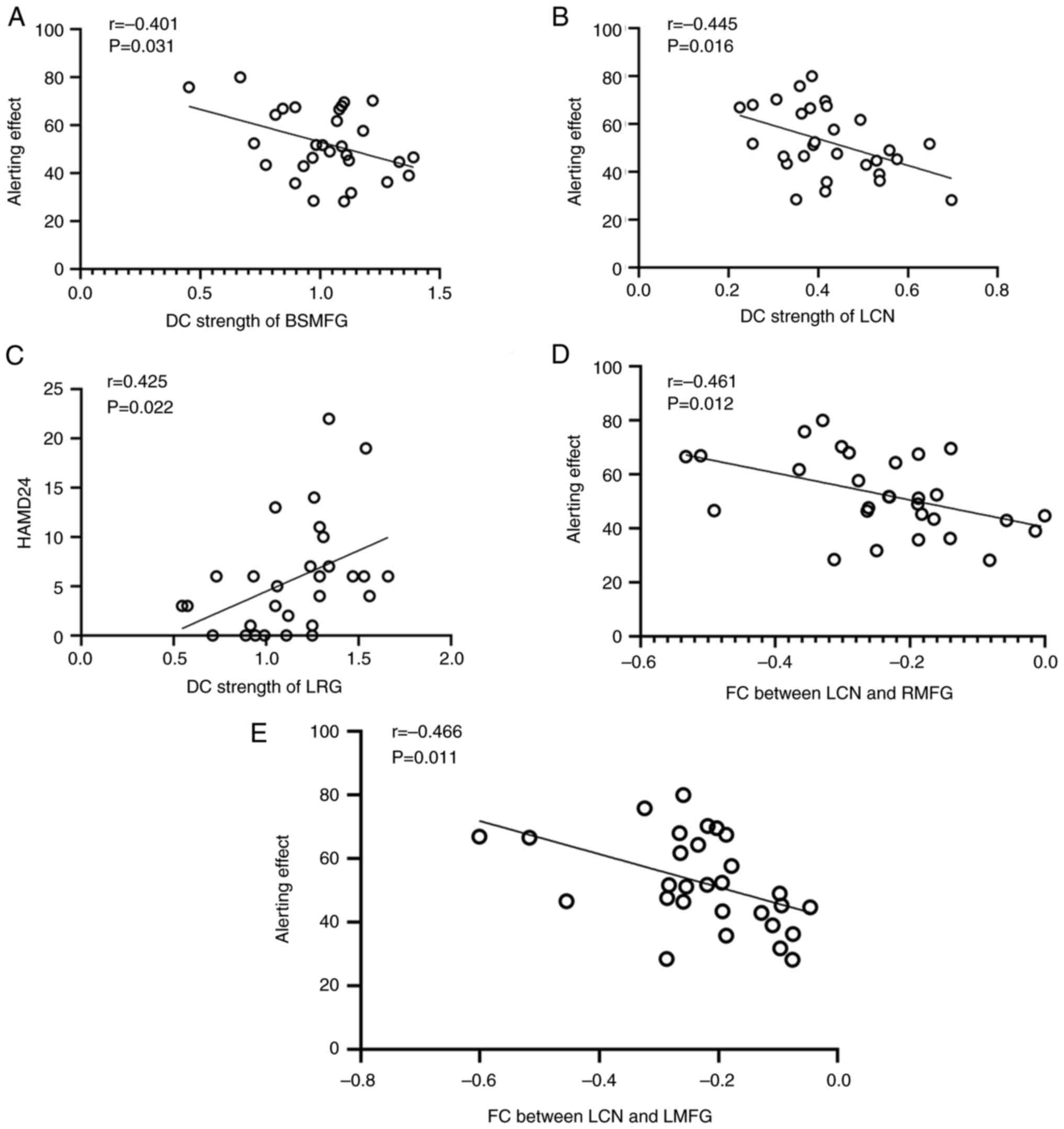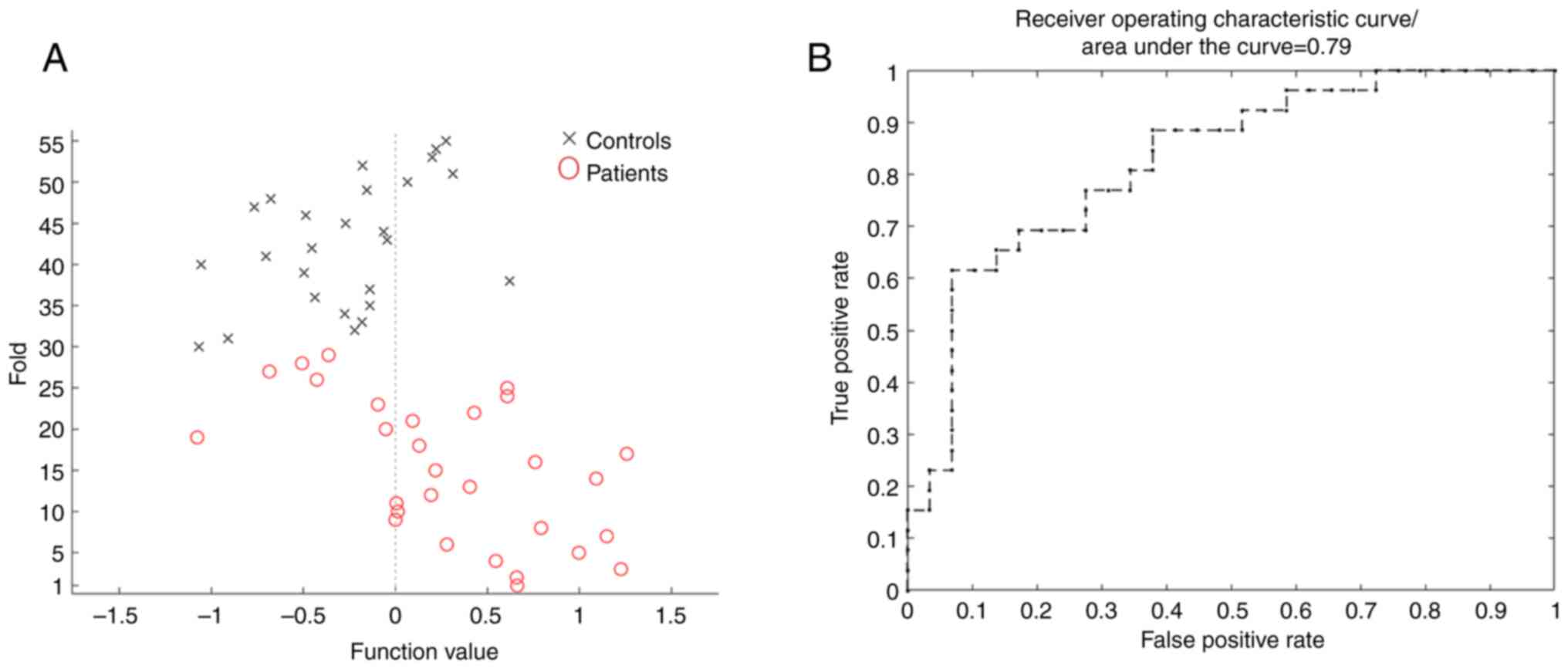|
1
|
Vitaliani R, Mason W, Ances B, Zwerdling
T, Jiang Z and Dalmau J: Paraneoplastic encephalitis, psychiatric
symptoms, and hypoventilation in ovarian teratoma. Ann Neurol.
58:594–604. 2005.PubMed/NCBI View Article : Google Scholar
|
|
2
|
Dalmau J, Tuzun E, Wu HY, Masjuan J, Rossi
JE, Voloschin A, Baehring JM, Shimazaki H, Koide R, King D, et al:
Paraneoplastic anti-N-methyl-D-aspartate receptor encephalitis
associated with ovarian teratoma. Ann Neurol. 61:25–36.
2007.PubMed/NCBI View Article : Google Scholar
|
|
3
|
Staley EM, Jamy R, Phan AQ, Figge DA and
Pham HP: N-Methyl-d-aspartate receptor antibody encephalitis: A
concise review of the disorder, diagnosis, and management. ACS Chem
Neurosci. 10:132–142. 2019.PubMed/NCBI View Article : Google Scholar
|
|
4
|
Neyens RR, Gaskill GE and Chalela JA:
Critical care management of Anti-N-Methyl-D-aspartate receptor
encephalitis. Crit Care Med. 46:1514–1521. 2018.PubMed/NCBI View Article : Google Scholar
|
|
5
|
Heine J, Kopp UA, Klag J, Ploner CJ, Prüss
H and Finke C: Long-Term cognitive outcome in
Anti-N-Methyl-D-Aspartate receptor encephalitis. Ann Neurol.
90:949–961. 2021.PubMed/NCBI View Article : Google Scholar
|
|
6
|
Dalmau J, Lancaster E, Martinez-Hernandez
E, Rosenfeld MR and Balice-Gordon R: Clinical experience and
laboratory investigations in patients with anti-NMDAR encephalitis.
Lancet Neurol. 10:63–74. 2011.PubMed/NCBI View Article : Google Scholar
|
|
7
|
Titulaer MJ, McCracken L, Gabilondo I,
Armangué T, Glaser C, Iizuka T, Honig LS, Benseler SM, Kawachi I,
Martinez-Hernandez E, et al: Treatment and prognostic factors for
long-term outcome in patients with anti-NMDA receptor encephalitis:
An observational cohort study. Lancet Neurol. 12:157–165.
2013.PubMed/NCBI View Article : Google Scholar
|
|
8
|
Nosadini M, Eyre M, Molteni E, Thomas T,
Irani SR, Dalmau J, Dale RC and Lim M: International NMDAR Antibody
Encephalitis Consensus Group. Anlar B, et al: Use and safety of
immunotherapeutic management of N-Methyl-d-Aspartate receptor
antibody encephalitis: A meta-analysis. JAMA Neurol. 78:1333–1344.
2021.PubMed/NCBI View Article : Google Scholar
|
|
9
|
Wang H and Xiao Z: Current progress on
assessing the prognosis for Anti-N-Methyl-D-aspartate receptor
(NMDAR) encephalitis. Biomed Res Int. 2020(7506590)2020.PubMed/NCBI View Article : Google Scholar
|
|
10
|
Guo Y, Lv X, Wei Q, Wu Y, Chen Y, Ji Y,
Hou Q, Lv H, Zhou N, Wang K and Tian Y: Impaired neurovascular
coupling and cognitive deficits in anti-N-methyl-D-aspartate
receptor encephalitis. Brain Imaging Behav. 16:1065–1076.
2022.PubMed/NCBI View Article : Google Scholar
|
|
11
|
Peer M, Prüss H, Ben-Dayan I, Paul F, Arzy
S and Finke C: Functional connectivity of large-scale brain
networks in patients with anti-NMDA receptor encephalitis: An
observational study. Lancet Psychiatry. 4:768–774. 2017.PubMed/NCBI View Article : Google Scholar
|
|
12
|
Xu J, Guo Y, Li J, Lv X, Zhang J, Zhang J,
Hu Q, Wang K and Tian Y: Progressive cortical and sub-cortical
alterations in patients with anti-N-methyl-D-aspartate receptor
encephalitis. J Neurol. 269:389–398. 2022.PubMed/NCBI View Article : Google Scholar
|
|
13
|
Finke C, Kopp UA, Scheel M, Pech LM,
Soemmer C, Schlichting J, Leypoldt F, Brandt AU, Wuerfel J, Probst
C, et al: Functional and structural brain changes in
anti-N-methyl-D-aspartate receptor encephalitis. Ann Neurol.
74:284–296. 2013.PubMed/NCBI View Article : Google Scholar
|
|
14
|
Liang Y, Cai L, Zhou X, Huang H and Zheng
J: Voxel-based analysis and multivariate pattern analysis of
diffusion tensor imaging study in anti-NMDA receptor encephalitis.
Neuroradiology. 62:231–239. 2020.PubMed/NCBI View Article : Google Scholar
|
|
15
|
Phillips OR, Joshi SH, Narr KL, Shattuck
DW, Singh M, Di Paola M, Ploner CJ, Prüss H, Paul F and Finke C:
Superficial white matter damage in anti-NMDA receptor encephalitis.
J Neurol Neurosurg Psychiatry. 89:518–525. 2018.PubMed/NCBI View Article : Google Scholar
|
|
16
|
Kerik-Rotenberg N, Diaz-Meneses I,
Hernandez-Ramirez R, Muñoz-Casillas R, Reynoso-Mejia CA,
Flores-Rivera J, Espinola-Nadurille M, Ramirez-Bermudez J and
Aguilar-Palomeque C: A Metabolic brain pattern associated with
Anti-N-Methyl-D-Aspartate receptor encephalitis. Psychosomatics.
61:39–48. 2020.PubMed/NCBI View Article : Google Scholar
|
|
17
|
Leypoldt F, Buchert R, Kleiter I,
Marienhagen J, Gelderblom M, Magnus T, Dalmau J, Gerloff C and
Lewerenz J: Fluorodeoxyglucose positron emission tomography in
anti-N-methyl-D-aspartate receptor encephalitis: Distinct pattern
of disease. J Neurol Neurosurg Psychiatry. 83:681–686.
2012.PubMed/NCBI View Article : Google Scholar
|
|
18
|
Yuan J, Guan H, Zhou X, Niu N, Li F, Cui L
and Cui R: Changing brain metabolism patterns in patients With
ANMDARE: Serial 18F-FDG PET/CT Findings. Clin Nucl Med. 41:366–370.
2016.PubMed/NCBI View Article : Google Scholar
|
|
19
|
Fan B, Wu P, Zhou X, Chen Z, Pang L, Shi K
and Zheng J: Aberrant resting-state interhemispheric functional
connectivity in patients with anti-N-methyl-D-aspartate receptor
encephalitis. Neuroradiology. 64:2021–2030. 2022.PubMed/NCBI View Article : Google Scholar
|
|
20
|
Wang JH, Zuo XN, Gohel S, Milham MP,
Biswal BB and He Y: Graph theoretical analysis of functional brain
networks: Test-retest evaluation on short- and long-term
resting-state functional MRI data. PLoS One.
6(e21976)2011.PubMed/NCBI View Article : Google Scholar
|
|
21
|
Zuo XN, Ehmke R, Mennes M, Imperati D,
Castellanos FX, Sporns O and Milham MP: Network centrality in the
human functional connectome. Cereb Cortex. 22:1862–1875.
2012.PubMed/NCBI View Article : Google Scholar
|
|
22
|
Van Den Heuvel MP and Hulshoff Pol HE:
Exploring the brain network: A review on resting-state fMRI
functional connectivity. Eur Neuropsychopharmacol. 20:519–534.
2010.PubMed/NCBI View Article : Google Scholar
|
|
23
|
Stam CJ, De Haan W, Daffertshofer A, Jones
BF, Manshanden I, van Cappellen van Walsum AM, Montez T, Verbunt
JP, de Munck JC, van Dijk BW, et al: Graph theoretical analysis of
magnetoencephalographic functional connectivity in Alzheimer's
disease. Brain. 132(Pt 1):213–224. 2009.PubMed/NCBI View Article : Google Scholar
|
|
24
|
Song L, Peng Q, Liu S and Wang J: Changed
hub and functional connectivity patterns of the posterior fusiform
gyrus in chess experts. Brain Imaging Behav. 14:797–805.
2020.PubMed/NCBI View Article : Google Scholar
|
|
25
|
Dutra LA, Abrantes F, Toso FF, Pedroso JL,
Barsottini OGP and Hoftberger R: Autoimmune encephalitis: A review
of diagnosis and treatment. Arq Neuropsiquiatr. 76:41–49.
2018.PubMed/NCBI View Article : Google Scholar
|
|
26
|
Nasreddine ZS, Phillips NA, Bédirian V,
Charbonneau S, Whitehead V, Collin I, Cummings JL and Chertkow H:
The montreal cognitive assessment, MoCA: A brief screening tool for
mild cognitive impairment. J Am Geriatr Soc. 53:695–699.
2005.PubMed/NCBI View Article : Google Scholar
|
|
27
|
Zigmond AS and Snaith RP: The hospital
anxiety and depression scale. Acta Psychiatr Scand. 67:361–370.
1983.PubMed/NCBI View Article : Google Scholar
|
|
28
|
Fan J, McCandliss BD, Sommer T, Raz A and
Posner MI: Testing the efficiency and independence of attentional
networks. J Cogn Neurosci. 14:340–347. 2002.PubMed/NCBI View Article : Google Scholar
|
|
29
|
Fonov V, Evans AC, Botteron K, Almli CR,
McKinstry RC and Collins DL: Brain Development Cooperative Group.
Unbiased average age-appropriate atlases for pediatric studies.
Neuroimage. 54:313–327. 2011.PubMed/NCBI View Article : Google Scholar
|
|
30
|
Aglieri V, Cagna B, Velly L, Takerkart S
and Belin P: FMRI-based identity classification accuracy in left
temporal and frontal regions predicts speaker recognition
performance. Sci Rep. 11(489)2021.PubMed/NCBI View Article : Google Scholar
|
|
31
|
Sheikh UA, Carreiras M and Soto D:
Decoding the meaning of unconsciously processed words using
fMRI-based MVPA. Neuroimage. 191:430–440. 2019.PubMed/NCBI View Article : Google Scholar
|
|
32
|
Schrouff J, Rosa MJ, Rondina JM, Marquand
AF, Chu C, Ashburner J, Phillips C, Richiardi J and Mourão-Miranda
J: PRoNTo: Pattern recognition for neuroimaging toolbox.
Neuroinformatics. 11:319–337. 2013.PubMed/NCBI View Article : Google Scholar
|
|
33
|
Shine JM, Breakspear M, Bell PT, Ehgoetz
Martens KA, Shine R, Koyejo O, Sporns O and Poldrack RA: Human
cognition involves the dynamic integration of neural activity and
neuromodulatory systems. Nat Neurosci. 22:289–296. 2019.PubMed/NCBI View Article : Google Scholar
|
|
34
|
Baek EC, Hyon R, López K, Finn ES, Porter
MA and Parkinson C: In-degree centrality in a social network is
linked to coordinated neural activity. Nat Commun.
13(1118)2022.PubMed/NCBI View Article : Google Scholar
|
|
35
|
Fuster JM: Frontal lobe and cognitive
development. J Neurocytol. 31:373–385. 2002.PubMed/NCBI View Article : Google Scholar
|
|
36
|
Henri-Bhargava A, Stuss DT and Freedman M:
Clinical assessment of prefrontal lobe functions. Behav Neurol
Psychiatry. 24:704–726. 2018.PubMed/NCBI View Article : Google Scholar
|
|
37
|
Paik E: Functions of the prefrontal cortex
in the human brain. J Korean Med Sci. 13:569–581. 1998.PubMed/NCBI View Article : Google Scholar
|
|
38
|
Miller EK and Cohen JD: An integrative
theory of prefrontal cortex function. Annu Rev Neurosci.
24:167–202. 2001.PubMed/NCBI View Article : Google Scholar
|
|
39
|
Miller EK: The prefrontal cortex and
cognitive control. Nat Rev Neurosci. 1:59–65. 2000.PubMed/NCBI View Article : Google Scholar
|
|
40
|
Uemura K, Shimada H, Doi T, Makizako H,
Tsutsumimoto K, Park H and Suzuki T: Reduced prefrontal oxygenation
in mild cognitive impairment during memory retrieval. Int J Geriatr
Psychiatry. 31:583–591. 2016.PubMed/NCBI View Article : Google Scholar
|
|
41
|
Mace RA, Waters AB, Sawyer KS, Turrisi T
and Gansler DA: Components of executive function model regional
prefrontal volumes. Neuropsychology. 33:1007–1019. 2019.PubMed/NCBI View Article : Google Scholar
|
|
42
|
Grahn JA, Parkinson JA and Owen AM: The
cognitive functions of the caudate nucleus. Prog Neurobiol.
86:141–155. 2008.PubMed/NCBI View Article : Google Scholar
|
|
43
|
Çırak M, Yağmurlu K, Kearns KN, Ribas EC,
Urgun K, Shaffrey ME and Kalani MYS: The caudate nucleus: Its
connections, surgical implications, and related complications.
World Neurosurg. 139:e428–e438. 2020.PubMed/NCBI View Article : Google Scholar
|
|
44
|
Mohan A, Roberto AJ, Mohan A, Lorenzo A,
Jones K, Carney MJ, Liogier-Weyback L, Hwang S and Lapidus KA: The
significance of the default mode network (DMN) in neurological and
neuropsychiatric disorders: A review. Yale J Biol Med. 89:49–57.
2016.PubMed/NCBI
|
|
45
|
Li J, Curley WH, Guerin B, Dougherty DD,
Dalca AV, Fischl B, Horn A and Edlow BL: Mapping the subcortical
connectivity of the human default mode network. Neuroimage.
245(118758)2021.PubMed/NCBI View Article : Google Scholar
|
|
46
|
Smallwood J, Bernhardt BC, Leech R, Bzdok
D, Jefferies E and Margulies DS: The default mode network in
cognition: A topographical perspective. Nat Rev Neurosci.
22:503–513. 2021.PubMed/NCBI View Article : Google Scholar
|
|
47
|
Tanglay O, Young IM, Dadario NB, Briggs
RG, Fonseka RD, Dhanaraj V, Hormovas J, Lin YH and Sughrue ME:
Anatomy and white-matter connections of the precuneus. Brain
Imaging Behav. 16:574–586. 2022.PubMed/NCBI View Article : Google Scholar
|
|
48
|
Hebscher M, Ibrahim C and Gilboa A:
Precuneus stimulation alters the neural dynamics of
autobiographical memory retrieval. Neuroimage.
210(116575)2020.PubMed/NCBI View Article : Google Scholar
|
|
49
|
Koziol LF, Budding D, Andreasen N,
D'Arrigo S, Bulgheroni S, Imamizu H, Ito M, Manto M, Marvel C,
Parker K, et al: Consensus paper: The cerebellum's role in movement
and cognition. Cerebellum. 13:151–177. 2014.PubMed/NCBI View Article : Google Scholar
|
|
50
|
Leggio M and Olivito G: Topography of the
cerebellum in relation to social brain regions and emotions. Handb
Clin Neurol. 154:71–84. 2018.PubMed/NCBI View Article : Google Scholar
|
|
51
|
Sbardella E, Upadhyay N, Tona F,
Prosperini L, De Giglio L, Petsas N, Pozzilli C and Pantano P:
Dentate nucleus connectivity in adult patients with multiple
sclerosis: Functional changes at rest and correlation with clinical
features. Mult Scler. 23:546–555. 2017.PubMed/NCBI View Article : Google Scholar
|
|
52
|
Zhou X, Zhang Z, Liu J, Qin L, Pang X and
Zheng J: Disruption and lateralization of cerebellar-cerebral
functional networks in right temporal lobe epilepsy: A
resting-state fMRI study. Epilepsy Behav. 96:80–86. 2019.PubMed/NCBI View Article : Google Scholar
|
|
53
|
Ahmadian N, Van Baarsen K, Van Zandvoort M
and Robe PA: The cerebellar cognitive affective syndrome-a
meta-analysis. Cerebellum. 18:941–950. 2019.PubMed/NCBI View Article : Google Scholar
|
|
54
|
Cai L, Liang Y, Huang H, Zhou X and Zheng
J: Cerebral functional activity and connectivity changes in
anti-N-methyl-D-aspartate receptor encephalitis: A resting-state
fMRI study. Neuroimage Clin. 25(102189)2020.PubMed/NCBI View Article : Google Scholar
|
|
55
|
Liang KJ and Carlson ES: Resistance,
vulnerability and resilience: A review of the cognitive cerebellum
in aging and neurodegenerative diseases. Neurobiol Learn Mem.
170(106981)2020.PubMed/NCBI View Article : Google Scholar
|
|
56
|
Flanagan EP, Geschwind MD, Lopez-Chiriboga
AS, Blackburn KM, Turaga S, Binks S, Zitser J, Gelfand JM, Day GS,
Dunham SR, et al: Autoimmune encephalitis misdiagnosis in adults.
JAMA Neurol. 80:30–39. 2023.PubMed/NCBI View Article : Google Scholar
|
|
57
|
Beutler BD, Moody AE, Thomas JM, Sugar BP,
Ulanja MB, Antwi-Amoabeng D and Tsikitas LA:
Anti-N-methyl-D-aspartate receptor-associated encephalitis: A
review of clinicopathologic hallmarks and multimodal imaging
manifestations. World J Radiol. 16:1–8. 2024.PubMed/NCBI View Article : Google Scholar
|
|
58
|
Lam SL, Criaud M, Lukito S, Westwood SJ,
Agbedjro D, Kowalczyk OS, Curran S, Barret N, Abbott C, Liang H, et
al: Double-Blind, Sham-controlled randomized trial testing the
efficacy of fMRI neurofeedback on clinical and cognitive measures
in children with ADHD. Am J Psychiatry. 179:947–958.
2022.PubMed/NCBI View Article : Google Scholar
|
|
59
|
Dadario NB and Sughrue ME: The functional
role of the precuneus. Brain. 146:3598–3607. 2023.PubMed/NCBI View Article : Google Scholar
|













